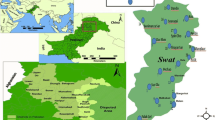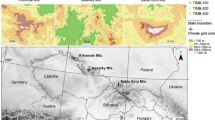Abstract
There is strong evidence that climate change alters tree growth in boreal forests. In Estonia, the analysis of ring measurements has been a common method to study growth changes. In this study, annual height growth data from dominant or co-dominant Scots pine (Pinus sylvestris L.) trees were used to develop a growth model for three forest generations. Stem analysis was applied and annual height growth was measured as the distance between whorls, as detected by branch knots of whorls on the split stem surface. Retrospective analysis of height growth produced comparative trends for three different age groups. Statistical analyses were used to estimate the impact of different factors on growth. Annual height growth was considered the best indicator for detecting possible trends in the growth potential of trees. Study results indicate that three generations (separated by time periods of 30–40 years) showed significant differences in growth patterns caused by shifts in climatic factors and management regimes (anthropogenic and natural disturbances).




Similar content being viewed by others
References
Ahas R, Aasa A (2006) The effects of climate change on the phenology of selected Estonian plant, bird and fish populations. Int J Biometeorol 51:17–26
Ainsworth EA, Long SP (2005) What have we learned from 15 years of free-air CO2 enrichment (FACE)? A meta-analytic review of responses of photosynthesis, canopy properties and plant production to rising CO2. New Phytol 165:351–372
Bontemps JD, Herve JC, Dhote JF (2009) Long-term changes in forest productivity: a consistent assessment in even-aged stands. For Sci 55:549–564
Bontemps JD, Herve JC, Dhote JF (2010) Dominant radial and height growth reveal comparable historical variations for common beech in north-eastern France. For Ecol Manag 259:1455–1463
Clutter JL, Fortson JC, Pienaar LV, Brister GH, Bailey RL (1983) Timber management: a quantitative approach. Wiley, New York
Curtis PS, Wang XZ (1998) A meta-analysis of elevated CO2 effects on woody plant mass, form and physiology. Oecologia 113:299–313
Danz NP, Reich PB, Frelich LE, Niemi GJ (2010) Vegetation controls vary across space and spatial scale in a historic grassland-forest biome boundary. Ecography. doi:10.1111/j.1600-0587.2010.06561.x
Elfving B, Tegnhammar L, Tveite B (1996) Studies on growth trends of forests in Sweden and Norway. In: Spiecker H, Mielikäinen K, Kohl M, Skovsgaard J (eds) Growth trends in European forests: studies from 12 countries. Springer, Berlin, pp 61–70
EMHI (2011) Estonian climate. Estonian Meteorological and Hydrological Institute. http://www.emhi.ee/. Accessed 2 Feb 2010
Eriksson H, Johansson U (1993) Yields of Norway spruce (Picea abies (L.) Karst.) in two consecutive rotations in southwestern Sweden. Plant Soil 154:239–247
Frelich LE, Reich PB (2010) Will environmental changes reinforce the impact of global warming on the prairie-forest border of central North America? Front Ecol Environ 8:371–378. doi:10.1890/080191
Grissino-Mayer HD (2001) Evaluating crossdating accuracy: manual and tutorial for the computer program COFECHA. Tree-Ring Res 57:205–221
Hari P, Nikinmaa E (2008) Response of boreal forest to climate change. In: Hari P, Kulmala L (eds) Boreal forest and climate change. Springer, Berlin, pp 499–503
Hari P, Arovaara H, Raunemaa T, Hautojärvi A (1984) Forest growth and the effect of energy production: a method for detecting trends in the growth potential of trees. Can J For Res 14:437–440
Hari P, Räisänen J, Nikinmaa E, Vesala T, Kulmala M (2008) Evaluation of the connections between boreal forest and climate change. In: Hari P, Kulmala L (eds) Boreal forest and climate change. Springer, Berlin, pp 519–528
Havimo M, Rikala J, Sirviö J, Sipi M (2008) Distributions of tracheid cross-sectional dimensions in different parts of Norway spruce stems. Silva Fenn 42:89–99
Holmes RL (1983) Computer-assisted quality control in tree-ring dating and measurement. Tree-Ring Bull 43:69–78
Kahle H-P, Karjalainen T, Schuck A, Ågren GI (eds) (2008) Causes and consequences of forest growth trends in Europe. EFI Res Rep No 21. Joensuu, Finland
Kangur A (2009) Long-term forest dynamics: permanent plot data for modeling. PhD thesis, Ecoprint, Tartu
Kangur A, Sims A, Jõgiste K, Kiviste A, Korjus H, von Gadow K (2007) Comparative modeling of stand development in Scots pine dominated forests in Estonia. For Ecol Manag 250:109–118
Karjalainen T, Spiecker H, Laroussinie O (eds) (1999) Causes and consequences of accelerating tree growth in Europe. EFI Proceedings No 27. Saarijärvi, Finland
Kiviste A (1997) Eesti riigimetsa puistute kõrguse, diameetri ja tagavara vanuseridade diferentsmudel 1984–1993. a. metsakorralduse takseerkirjelduste andmeil [difference equations of stand height, diameter and volume depending on stand age and site factors for Estonian state forests]. Eesti Põllumajandusülikooli teadustööde kogumik, 189, pp 63–75
Kiviste A (1999) Site index change in the 1950s–1990s according to Estonian Forest Inventory data. In: Karjalainen T, Spiecker H, Laroussinie O (eds.) Causes and consequences of accelerating tree growth. Eur For Inst Proc 27:87–100
Kiviste A, Kiviste K (2009) Algebraic difference equations for stand height, diameter, and volume depending on stand age and site factors for Estonian state forests. Math Comput For Nat-Res Sci 1:67–77
Kiviste A, Alvares Gonzalez JG, Rojo Alboreca A, Ruiz Gonzalez AD (2002) Functiones de creciniento de aplicacion en el ambito forestal. MONOGRAFIAS INIA: FORESTAL 4, Madrid
Konôpka B, Pajtík J, Moravèíka M, Lukac M (2010) Biomass partitioning and growth efficiency in four naturally regenerated forest trees species. Basic Appl Ecol 11:234–243
Lebourgeois F, Becker M, Chevalier R, Dupouey J-L, Gilbert J-M (2000) Height and radial growth trends of Corsican pine in western France. Can J For Res 30:712–724
Lloyd AH, Bunn AG (2007) Response of the circumpolar boreal forest to 20th century climate variability. Environ Res Lett 2:045013. doi:10.1088/1748-9326/2/4/04513
Lloyd AH, Fastie CH (2002) Spatial and temporal variability in the growth and climate response of treeline trees in Alaska. Clim Change 52:481–509
Lopatin E (2007) Long-term trends in height growth of Picea obovata and Pinus sylvestris during the past 100 years in Komi Republic (north-western Russia). Scand J For Res 22:310–323
Mäkinen H, Isomäki A (2004) Thinning intensity and growth of Scots pine stands in Finland. For Ecol Manag 201:311–325
Mellert KH, Prietzel J, Straussberger R, Rehfuess KE (2004) Long-term nutritional trends of conifer stands in Europe: results from the RECOGNITION project. Eur J For Res 123:305–319
Mielikäinen K, Sennov S (1996) Growth trends of forests in Finland and North-Western Russia. In: Spiecker H, Mielikäinen K, Köhl M, Skovsgaard JP (eds) Growth trends in European forests. Springer, Berlin, pp 19–27
Mielikäinen K, Timonen M (1996) Growth trends of Scots pine (Pinus Sylvestris L.) in unmanaged and regularly managed stands in Southern and Central Finland. In: Spiecker H, Mielikäinen K, Köhl M, Skovsgaard JP (eds) Growth trends in European forests. Springer, Berlin, pp 41–60
MMK (2008) Yearbook forest 2008. Keskkonnaministeerium. Metsakaitse- ja Metsauuenduskeskus, Tartu, Estonia
Nilson A, Kiviste A (1986) Reflection of environmental changes in models of forest growth composed using different methods. In: Antanaitis VV, Baltrunaitis RJ, Mastauskis MM, Juknis RA (eds) Monitoring of forest ecosystems. Abstacts of scientific conference, June 5–6, 1986. Kaunas-Akademija, Kaunas, pp 336–337 (in Russian)
Nilson A, Kiviste A, Korjus H, Mihkelson S, Etverk I, Oja T (1999) Impact of recent and future climate changes on Estonian forestry and adaptation tools. Clim Res 12:205–214
Pärn H (2008) Männipuistute radiaalkasvust muutuvates keskkonnatingimustes [Radial growth of pine stands in changing environmental conditions]. Metsanduslikud uurimused 48:41–52
Pilcher JR (1990) Sample preparation, cross-dating and measurement. In: Cook E, Kairiukstis L (eds) Methods of dendrochronology: applications in the environmental sciences. Kluwer, Dordrecht, pp 40–51
Pretzsch H (2009) Forest dynamics, growth and yield: from measurement to model. Springer, Berlin
Rautiainen M, Nilson T, Lükk T (2009) Seasonal reflectance trends of hemiboreal birch forests. Remote Sens Environ 113:805–815
Richards FJ (1959) A flexible growth function for empirical use. J Exp Bot 10:290–300
Rinn F (2003) TSAP-Win. Time series analysis and presentation for dendrochronology and 409 related applications. User reference, Heidelberg
R Development Core Team (2009) R A language and environment for statistical computing. R Foundation for Statistical Computing, Vienna. http://www.R-project.org. Accessed 28 June 2010
Salminen H, Jalkanen R, Lindholm M (2009) Summer temperature affects the ration of radial and height growth of Scots pine in northern Finland. Ann For Sci 66:810
Sims A, Hordo M, Kangur A, Kiviste A, Jõgiste K, Gadow Kv (2009) Tracking disturbances induced changes in stand development on irregular measurement intervals in the Järvselja forest experiments. Balt For 15:151–160
Sinkevich SM, Lindholm M (1996) Short- and long-term natural trends of Scots pine (Pinus sylvestris L.) radial growth in North- and Mid-Taiga forests in Karelia. In: Spiecker H, Mielikäinen K, Köhl M, Skovsgaard JP (eds) Growth trends in European forests. Springer, Berlin, pp 29–40
Spiecker H (1999) Overview of recent growth trends in European forests. Water Air Soil Poll 116:33–46
Solberg B, Moiseleyev A, Kallio AMI (2003) Economic impacts of accelerating forest growth in Europe. For Policy Econ 5:157–171
Untheim H (1996) Has site productivity changed? A case study in the Eastern Swabian Alps, Germany. In: Spiecker H, Mielikäinen K, Köhl M, Skovsgaard JP (eds) Growth trends in European forests. Springer, Berlin, pp 133–147
Wenk G, Vogel M (1996) Height growth investigations of Norway spruce (Picea abies [L.] Karst.) in the Eastern Part of Germany during the last century. In: Spiecker H, Mielikäinen K, Köhl M, Skovsgaard JP (eds) Growth trends in European forests. Springer, Berlin, pp 99–106
Spiecker H, Mielikäinen K, Köhl M, Skovsgaard JP (eds) (1996) Growth trends in European forests. Springer, Berlin, pp 7–18
Wild M, Gilgen H, Roesch A, Ohmura A, Long CN, Dutton EG, Forgan B, Kallis A, Russak V, Tsvetkov A (2005) From dimming to brightening: decadal changes in solar radiation at Earth’s surface. Science 308:847–850
Wood SN (2006) Generalized additive models: an introduction with R. Chapman and Hall/CRC Press, Virginia Beach
Zeide B (1993) Analysis of growth equations. For Sci 39:594–616
Zetterberg P, Eronen M, Lindholm M (1996) Construction of a 7500-year tree-ring record for Scots Pine (Pinus sylvestris L.) in northern Fennoscandia and its application to growth variation and palaeoclimatic studies. In: Spiecker H, Mielikäinen K, Köhl M, Skovsgaard JP (eds) Growth trends in European forests. Springer, Berlin, pp 7–18
Acknowledgments
This study was supported by Järvselja Training and Experimental Forest Centre, Estonian Environmental Investment Centre, State Forest Management Centre, Metsämiesten Säätiö and The Ministry of Education and Research (project SF0170014s08 and grant no ETF8890). We are very grateful to Lee E. Frelich, University of Minnesota, for discussion and language correction.
Author information
Authors and Affiliations
Corresponding author
About this article
Cite this article
Metslaid, S., Sims, A., Kangur, A. et al. Growth patterns from different forest generations of Scots pine in Estonia. J For Res 16, 237–243 (2011). https://doi.org/10.1007/s10310-011-0275-4
Received:
Accepted:
Published:
Issue Date:
DOI: https://doi.org/10.1007/s10310-011-0275-4




